Thinning seedlings is important in order to grow strong and healthy plants. If you don’t know when or how to thin seedlings (or why the heck you need to do it in the first place), then this post is for you!
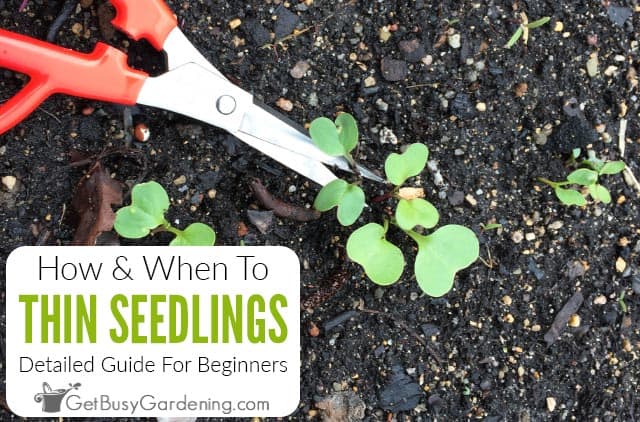
I know first hand that thinning seedlings can be a really touchy subject, especially for new gardeners. What, thin my seedlings?!? Eek!
But overcrowded plants will suffer from all kinds of problems down the road if they aren’t spaced out properly.
In a perfect world, every single seed we plant would grow, and it would be easy to space them all correctly from the start.
But, here in the real world, it is not that simple. We know that some of them won’t germinate, so we plant more than what we need to make up for it.
Plus, it’s pretty much impossible to plant tiny little seeds one by one. So we sprinkle them over the top of the dirt instead. Then we end up with overcrowded starts!
That’s why learning how to thin them out is a very important part of successful seedling care.
Don’t worry, it’s not difficult. In this detailed guide, I will walk you through everything, step by step.
What Does It Mean To Thin Seedlings?
In gardening, thinning seedlings simply means removing some of the ones that were planted too close together, so that only the best and strongest ones are left to thrive.
It is a common practice that’s used to ensure the proper spacing of plants in the garden, especially for those that were sown too close together.
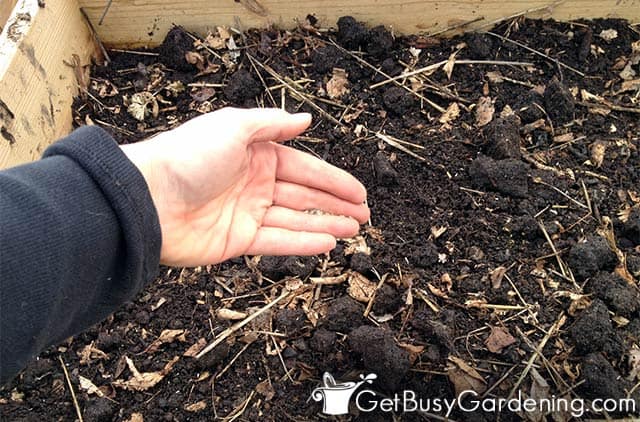
Why Thin Seedlings?
Thinning crowded seedlings ensures that your plants have plenty of room to grow. If they’re too close together, they will eventually end up competing with each other.
This means that, as they mature, their growth will be stunted. Indoors, overcrowded starts won’t get enough air circulation, which can cause mold in your seed trays.
I know it’s difficult, but it is necessary when plants are too close together in the garden, or if there’s more than one per tray cell, pellet, or pot indoors.
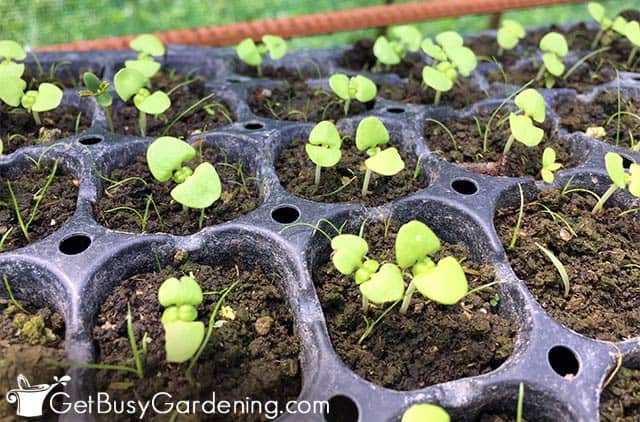
Do You Have To Thin Seedlings? Can’t I Just Separate Them?
Yes, you certainly can try to separate some types of seedlings instead of thinning them out. I have had luck doing this with larger ones.
But I don’t do it much anymore. It’s too risky, and it’s a total waste of time to plant the damaged ones that won’t amount to much.
Plus, the task of carefully separating each of the tiny starts is way more tedious than just cutting them out.
If you really, really hate the thought of killing perfectly good seedlings, then the best way to avoid it in the future is to take extra time to space out the seeds properly when you plant them.
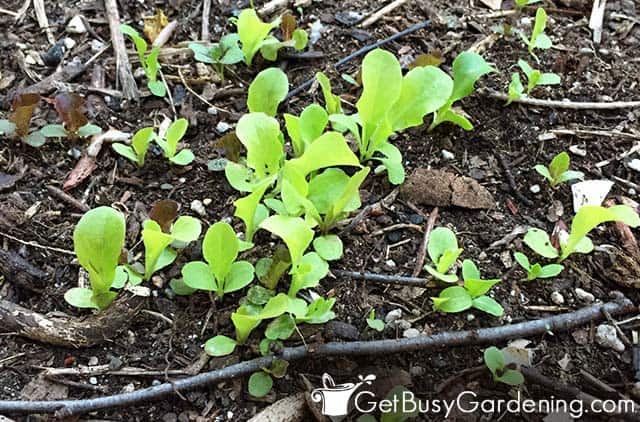
When To Thin Seedlings Indoors & Out
To give your plants a healthy start to life, they need plenty of space right from the beginning. So the sooner you thin your seedlings, the better.
The longer you wait, the more you risk stunting their development (and, when you have a super short gardening season like we do here in MN, they need all the time they can get to mature).
If you decide to give it more time, then plan to do it once they get a few sets of true leaves. But not more than 3-4 sets.
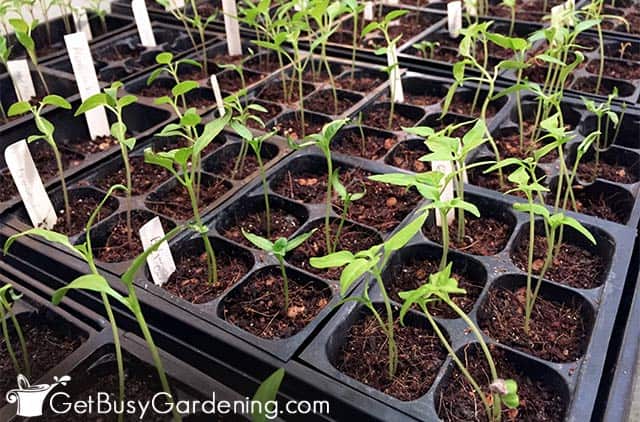
How To Thin Seedlings Step-By-Step
Sometimes it can be tough to visualize how to thin seedlings correctly. So, I thought I’d break it down into simple steps for you to follow.
I included lots of pictures because I’m a visual learner, and some of you probably are too. Here are the simple step by step instructions…
Step 1. Decide which ones to cut out – Choose the strongest seedling in the bunch to keep, and then thin out the rest.
To pick the strongest, look for the one that is the most compact, and has the thickest stem. If they’re all the same size, then just pick the one that looks the best.
Step 2. Use the right tool – Regular pruning shears are way too big and clumsy to use for this delicate job, and it’s easy to accidentally damage the other seedlings in the process.
So I recommend using a small micro-tip snip or bonsai shears for precision cuts. Also, be sure to disinfect the blades first. To do that, simply dip them into rubbing alcohol, or wash them with soapy water.
Step 3. Cut the weak seedlings off at the base – It’s very important that you cut the stems off at the base, rather than pinching them out.
And never try to pull the seedlings out of the soil while thinning. Doing that can damage the delicate roots of the others, which could end up killing them too.
This is especially important for root crops. One of the main causes of deformities is damage to the roots when plants are young.
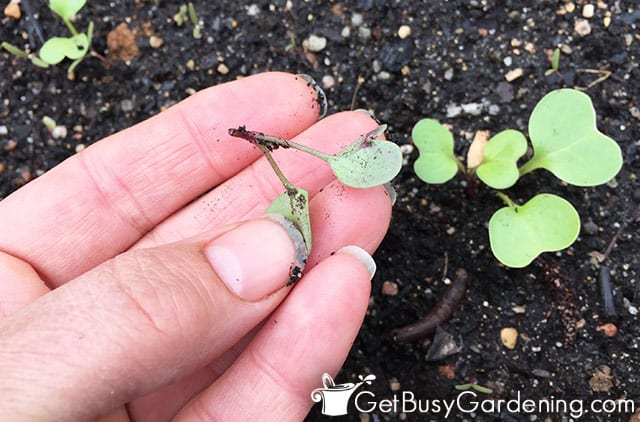
Step 4. Fertilize the remaining seedlings – Once you’re done thinning the seedlings to the proper spacing, give the remaining ones a shot of fertilizer for an extra boost.
Use a starter fertilizer, or try compost tea (which you can get in liquid form or buy tea bags to brew your own). Seedlings also love liquid kelp or fish emulsion.
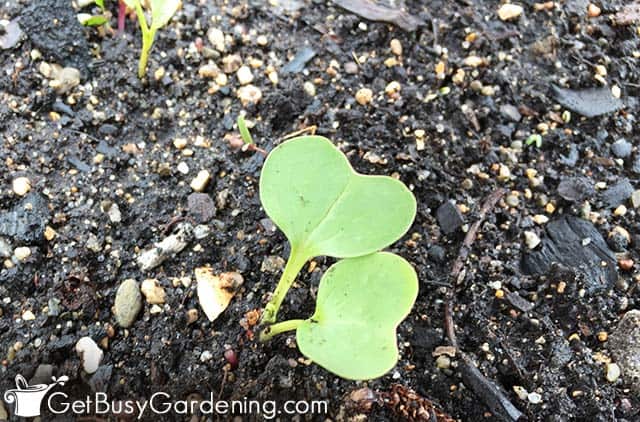
How To Pick The Strongest Seedling
To pick the strongest seedling, find the healthiest, and most compact one in the group. That’s the one you want to keep. Then thin out the others.
If they all look equally healthy, then cut out the smallest or weakest looking ones. Just keep in mind that the tallest ones aren’t always the healthiest.
They grow tall and leggy when they don’t get enough light. So remove the ones that have become weak or scraggly looking.
If the seedlings are all the same size, then you can just randomly thin them out. Or give it a bit more time to see if one of them gets larger than the others. But really, in this case, you can’t make the wrong choice, so cut away.
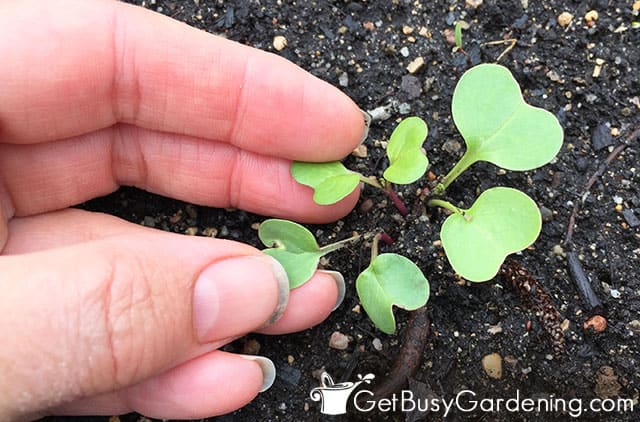
How Much Thinning Do I Need To Do?
If your seedlings are indoors, then you should thin them out until there is only one left in each cell, pellet, or pot.
Not only will this give them plenty of room to grow, but it also makes it much easier when it comes time for transplanting them into the garden.
Seedlings that were sown directly in the ground, rather than started indoors, should be thinned to the spacing requirements on the seed packet.
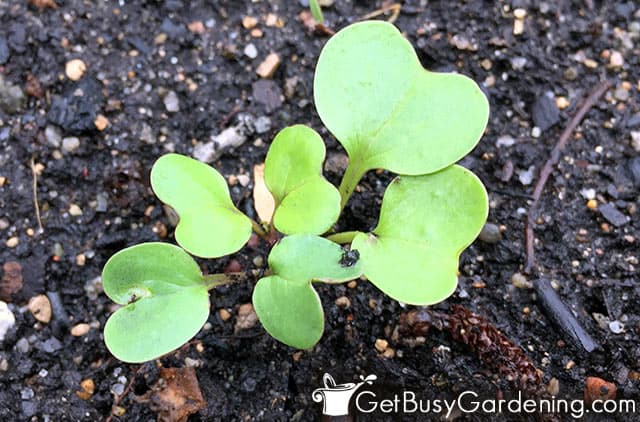
FAQs
In this section, I will answer some of the most commonly asked questions that I get about thinning seedlings. If you still have a question after reading through these, then ask it in the comments below.
Can you replant thinned seedlings?
No, unfortunately you cannot replant thinned out seedlings. After cutting them off at the base, they will eventually die. However, you can use the edible ones as microgreens, they are delicious in salads!
How big should seedlings be before thinning?
It’s usually best to wait until seedlings have their first set of true leaves before thinning them.
That way, you’ll know which ones have successfully unfurled. But don’t wait too long, or overcrowding could begin to stunt their growth.
How do you thin seedlings without killing them?
Unfortunately, there’s no way to properly thin seedlings without killing them. If you try to separate them, rather than pruning out the weakest ones, you risk killing them all.
If you can’t stomach the thought of killing them in this way, then make sure you properly space the seeds next time you plant them.
Thinning seedlings is a necessary evil when they become overcrowded. But proper spacing is crucial for growing healthy plants. So, even though it can be really hard, it’s very important to learn how to thin out your seedlings.
If you’re a new gardener and want to learn how to grow any plant you want from seed, check out my online Seed Starting Course! It’s a wonderful, comprehensive and completely self-paced online course that will teach you everything you need to know about successfully growing garden seeds. Enroll and get started today!
Otherwise, if you just need a quick refresher for planting them indoors, then my Starting Seeds Indoors eBook is exactly what you need.
More Posts About Seedlings
Share your tips about how to thin seedlings in the comments section below.
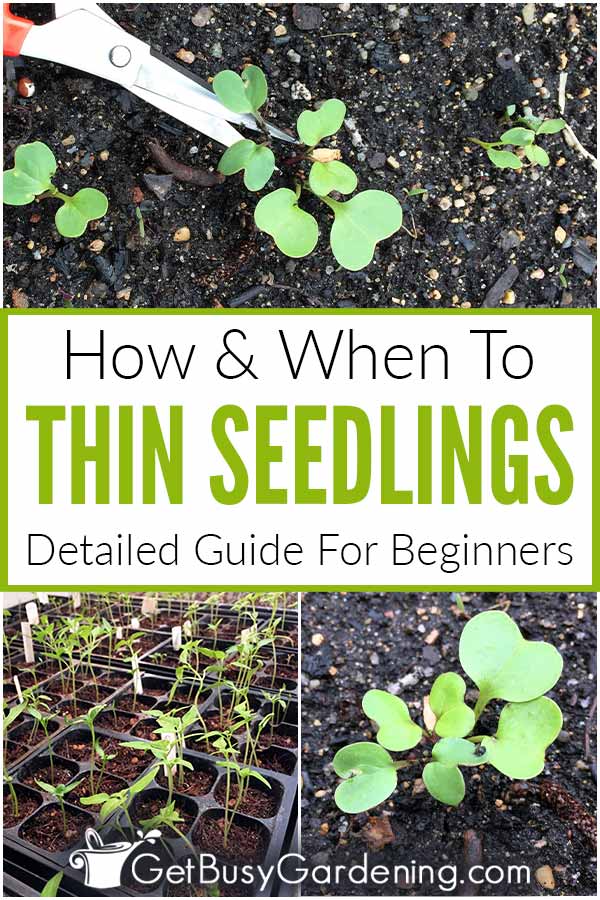
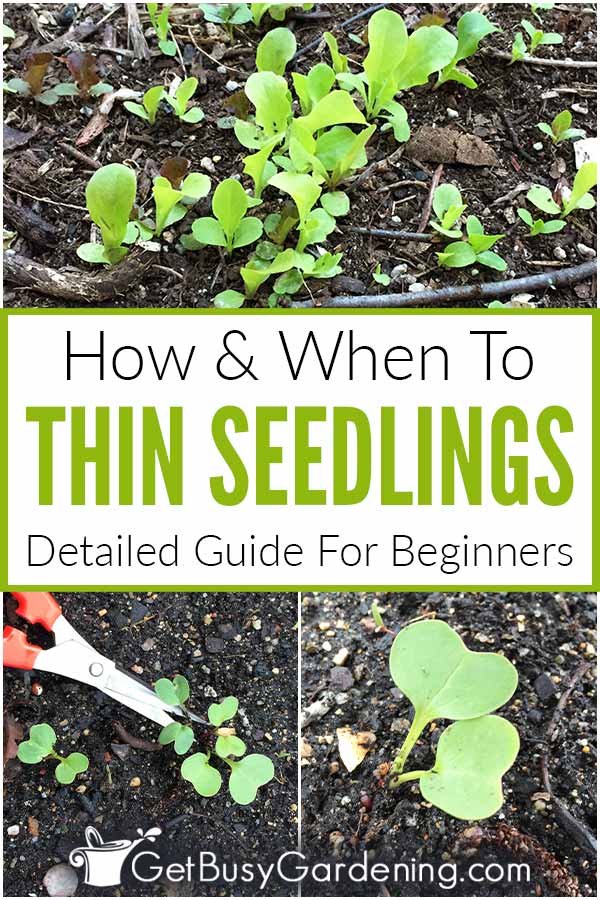
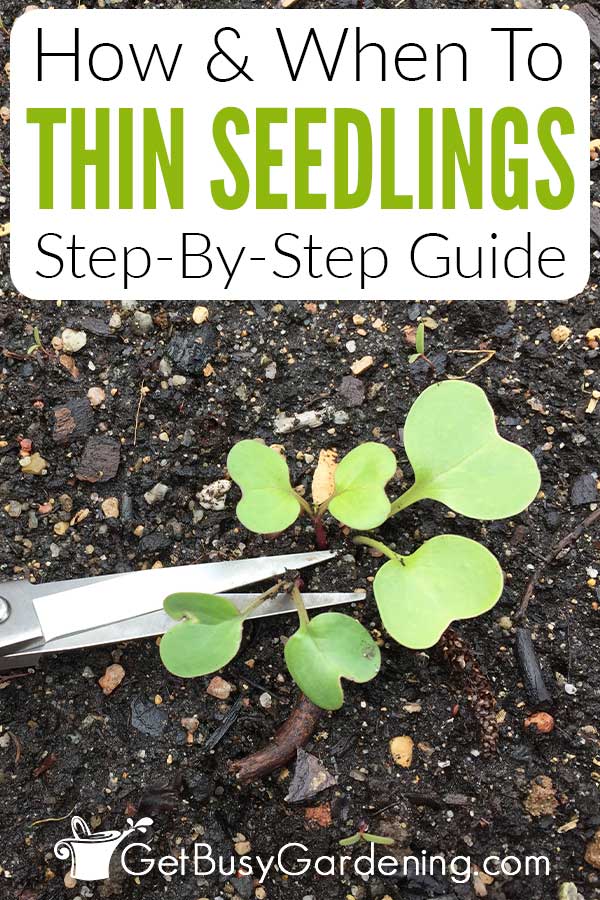
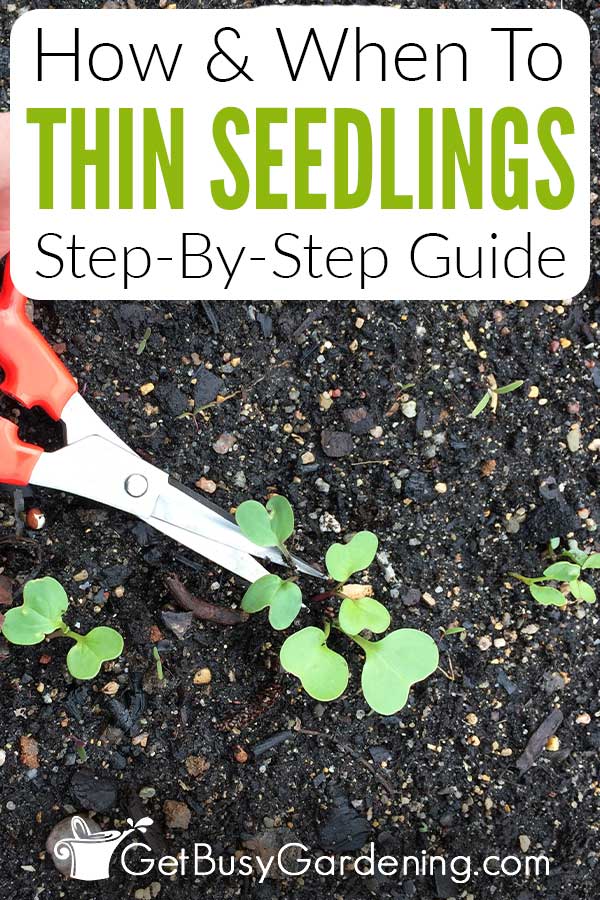
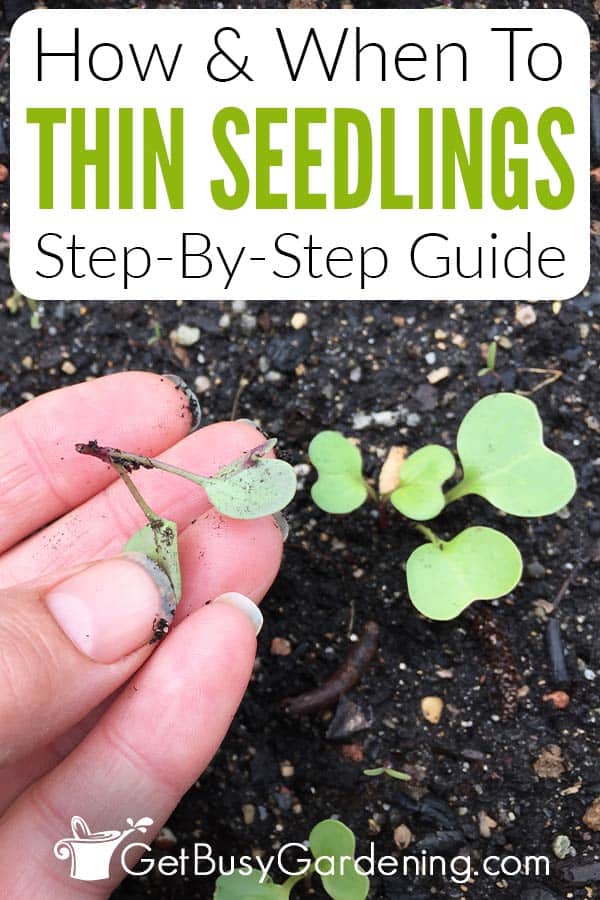
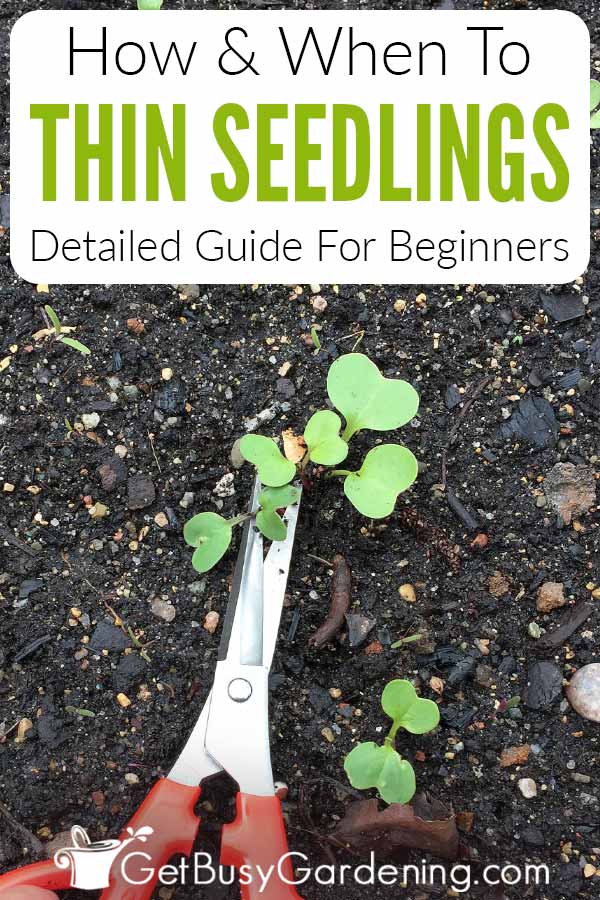

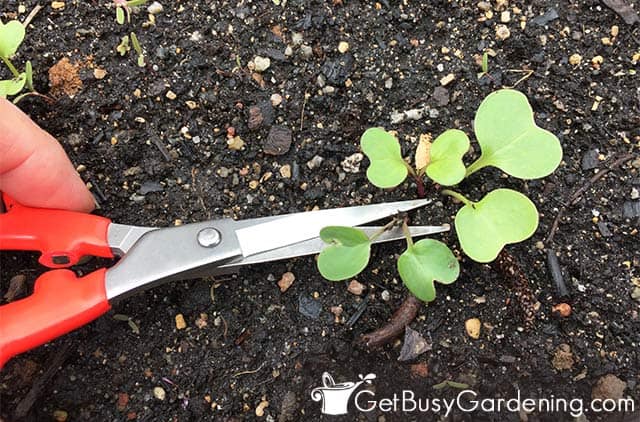
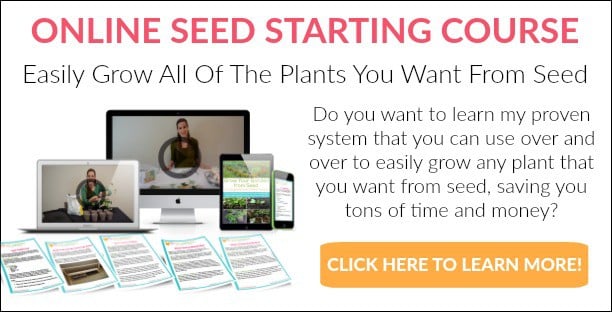

Remi says
How do we know which stems belong to which plant? I have several radishes close together but each plant seems to have several stems, if that makes sense !
Amy Andrychowicz says
If your seedlings appear to have several stems, then they are definitely way too close together. Simply choose the strongest stem, and pinch out the other weaker stems to thin them.
Alysha says
Thanks so much for your information. I was really scared of cutting them but, it is what it is.
Amy Andrychowicz says
You’re welcome. Thinning them will be better for your seedlings in the long run, so just think about that when you’re cutting them next time. 🙂
Caridad Pineiro says
Thanks for the guide to thinning the seedlings. I’m trying to start some seeds for heirloom varieties that I probably won’t find in the store.
Amy Andrychowicz says
You’re welcome, and good luck with your heirloom seeds!
Hope Firenze says
I’m wondering if it’s too late to thin my beets, Swiss chard & carrots? They have been in the ground for 2 months & are only 4”. I live on the coast just south of San Francisco. I’m glad I found your site, I will try again. I’m new to gardening & this teaches me a lot. Thanks
Amy Andrychowicz says
If your seedlings are overcrowded, then that is probably why they’re still so small. I would definitely try thinning them out to see if that triggers them to grow faster/larger.
Robert says
Hi Amy, I unfortunately came across your thinning instructions a day late. I thinned my sugar snap peas today according to the seed packet instructions but I just pulled them out of the ground. I had no idea you were supposed to cut them off at the base. What do you think the prognosis is for the remaining seedlings? I will fertilize them with some worm castings tomorrow.
Amy Andrychowicz says
Oh shoot! Yes, peas don’t like to have their roots disturbed. The best you can do at this point is monitor the remaining seedlings to make sure they weren’t damaged while you were thinning. Fertilizer will not matter, the concern is that the tiny roots of the nearby seedlings could have been damaged when you pulled out the others. If they were damaged, the seedlings will usually start to die back fairly quickly. If they all look good after a few days, then you can breath a sigh of relief! 🙂
LIsa Hiland says
Hi Amy. I am so glad I stumbled upon your site. I live in the upper part of North Dakota so your information will be helpful. I live on a military installation so I shave to grow my veggies, herbs and flowers in containers; this is also an easier way for me to garden since I also have physical limitations. This is the first year that I have put in a good size patio garden and I am already thinking about what I want to plant next year.
Amy Andrychowicz says
Great, you’re welcome! It’s never too soon to start planning for next year. 🙂
Alvin A.A. says
Hi Amy, your posts are good, easy to understand and very useful 🙂
Warm greetings and thank you from Sunny Kuala Lumpur!
Amy Andrychowicz says
Thank you very much, I’m so glad you like them! 🙂
Ivory says
Bless you for this. I am so new, so nervous, and scared at the same time. I wish I could send you a pic of my container carrots in which I think maybe tooooo much.
Amy Andrychowicz says
You’re welcome! Thin your seedlings so that they are 3-4″ apart. Here’s a post about how to grow carrot seeds for even more details.
Pastor John says
My thinning motto, keep the best, thin out the rest. Very successful method and simple.
Amy Andrychowicz says
Yes, that is a perfect way to summarize how to thin seedlings! Thanks for sharing your motto.
Veronica Greer says
Thank you for the lesson. I’m glad I chose your website from the list Google gave me after typing in “What do they mean when they say to thin seedlings?”
This is my 2nd time time I am planting flowers in my yard. I say 2nd time because I didn’t plant any last year.
I’m in a new house and cannot wait to make the property look beautiful like I did my part old place.
My 1st time was purely an accident that everything bloomed so beautifully exactly how I imagined. I had no idea what I was doing. Ha! But after they started coming up and I could see growth and color and awesome life, I fell in love. I’d be out in my yard every minute before work and as soon as I got home from work i would spend the afternoons tending to them.. adding things, moving things, whatever. I loved it. Plus, it is very therapeutic I think. I was a young widow and my yard kept me busy which was what I needed.
Anyway, thanks again for your knowledge. I’m browse your site to learn some more of what you articulate so we’ll. I appreciate you!
Amy Andrychowicz says
Awesome, so glad that you found this article about thinning seedlings helpful! 🙂 Glad to hear you’ve had such wonderful success with your flower gardens, and hope they will grow just as well for you this year! Thanks for your kind words, you made my day!
Janet says
Correct me if I am wrong but, some can be eaten on a salad as micro greens, right?
Amy Andrychowicz says
Yes, as long as they are edible plants, you can use the seedlings you thin out as micro greens. Yummy!
Alex Little says
Looking for some advice on whether creeping thyme, which I planted in early spring indoors, requires thinning. The seeds are incredibly tiny so now, a few weeks later, I’ve got a pretty dense collection of seedlings in each little pot. But they are very tiny as it’s a delicate plant so trying to thin them will be challenging. And creeping thyme tends to be a dense plant anyway…so thoughts on whether I should go ahead and try to thin them out?
Amy Andrychowicz says
Yes, unfortunately, it would be best to thin the seedlings in order to get the best plants. I know it’s hard to work with tiny seedlings, so you could give them a bit more time to mature before you try to thin them. Or just take some time to thin a few of them now, and then work to thin more as the seedlings grow larger. Next time, I recommend planting less seeds in each pot. I would only plant 3-5 seeds in each pot to make thinning and transplanting much easier. Good luck!
Roger says
Hi,
I’m a newbie to this and found your information very helpful.
A lot of what I’ve planted has information on the seed packet saying things like ” when the shoots are around two inches tall thin to 6″ apart.
I presumed I had to pull out the excess shoots but now thanks to you I know better,
I also see the reasoning behind the practice and won’t (hopefully) feel so guilty about removing perfectly good plants.
Thanks
Amy Andrychowicz says
Wonderful, so glad you found this helpful! Yes, it may take some time to get used to thinning your seedlings without feeling guilty, but remember that it’s best for the long-term health of your plants! 🙂
Sara says
I needed this! Good read, thank you
Amy Andrychowicz says
You’re welcome!
Barbara Fowler says
I never thin my plants but I’m going to start to. I live in a shabby trailer so I get to the point where I don’t want to do much of anything. What I want to know is why can’t you save the plants that you thin and replant them? I don’t see why you should plant extra seeds if you are going to throw the thinned ones away. Is it wrong to thin by pulling the seedlings up by the root and replant them? I planted American Giant Sunflowers in a large container and they are 2]to 3 feet tall. They are starting to flower. If I thin them, then I lose 7 out of 8 plants. I’ll thin by uprooting the 7 plants and replant them individually in pots. How should I thin them properly?
Amy Andrychowicz says
If you want to try dividing the seedlings rather than thinning them, then I definitely would not recommend pulling them out of the soil. Seedlings roots are extremely delicate, and pulling them out would likely end up killing them. For large ones like sunflowers, it’s pretty easy to divide them. Just remove the entire clump from the pot, and gently (very, very gently) tease the roots apart until they’re divided. Then pot them up into their own containers. Don’t try this with root crops like carrots or radishes though, because any damage to the roots can cause deformities to the crop. There are a few reasons to plant extra seeds and then thin them, like maybe you’re using old seeds with low viability rate. So planting a few extras will give you better chances that at least one will grow. Another reason is that sometimes it’s easier to thin seedlings than it is to meticulously plant the teeny tiny seeds. And, as I mentioned, some seedlings don’t like to be disturbed or transplanted, so they must be thinned rather than divided.
Laura says
This is such a wonderful post on thinning seeds! As much as I love planting seeds indoors with my 2 girls, I get all weird when it gets time to thin them out. But your explanation about why it’s so important has helped me get over my hesitation, and I’m going to go thin mine out right now!
Amy Andrychowicz says
Awesome, glad you found it helpful!